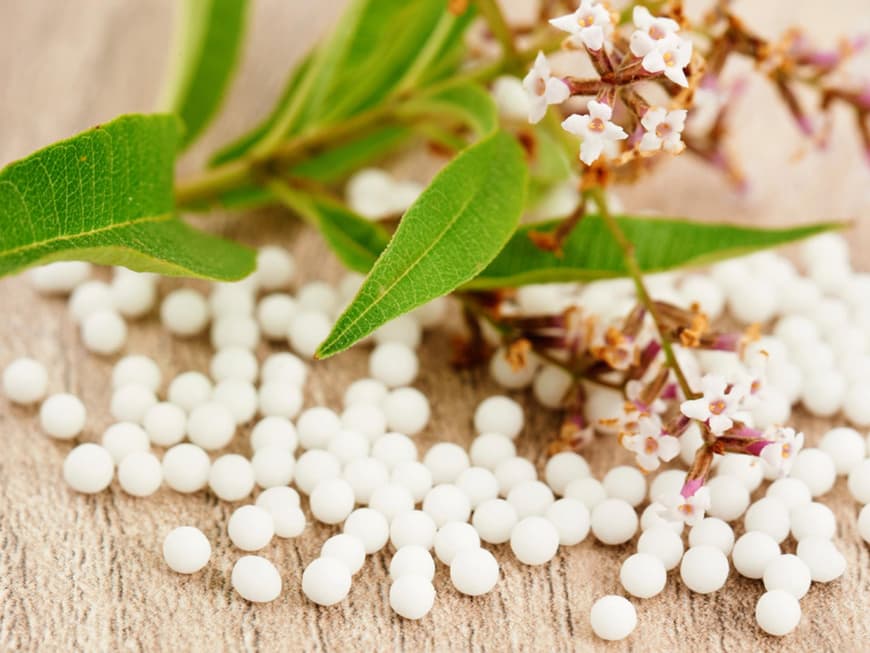
Incidentally, the inventor of homeopathic remedies is Samuel Hahnemann (1755-1843), who discovered over 200 years ago that like cures like.
Dosage of homeopathic remedies
For self-therapy with homeopathic remedies - and unless otherwise prescribed - you are on the safe side with D12 potencies. Depending on the severity of the symptoms, take three globules or drops two to four times a day. If there is an improvement, reduce the dose until the symptoms subside. Stop taking them completely after 14 days at the latest.
Use of homeopathic remedies
Allow tablets and globules to dissolve slowly under the tongue and hold drops in the mouth for some time before swallowing. Important: do not drink coffee or tea or brush your teeth for half an hour before and after taking the remedy. This is because toothpaste often contains essential oils such as menthol, which can impair the effect of homeopathic remedies.
Ear, nose and throat
Belladonna
Homeopathy can also relieve a sore throat or cold. Belladonna is the most important homeopathic remedy for all acute inflammations, especially in the head area. Whether for tonsillitis, sinus problems or a sudden middle ear infection - Belladonna helps.
Back
Rhus toxicodendron
The worst time is immediately after getting up: your back hurts, your joints are stiff and every movement hurts. Do you often feel like this in the morning or after long periods of rest? Then Rhus toxicodendron is the right homeopathic remedy for you. It is also highly recommended for rheumatism.
Hormones
Pulsatilla
This is the most frequently purchased homeopathic remedy for women. Whether hormonal disorders during puberty, pregnancy or the menopause - this remedy brings the hormones back into balance. Also helps with PMS
Gastrointestinal
Nux vomica
The so-called nux vomica has a central effect on our digestive tract and thus successfully helps with nausea and vomiting, flatulence, cramps, abdominal pain, constipation and diarrhea.
Injuries
Arnica
Whether a bruise, a bump, contusions or sprains - Arnica is the undisputed number 1 for all blunt - i.e. non-open - injuries. It is available for ingestion and as a homeopathic ointment for external use.
Headaches
Gelsemium
According to the experience of the well-known Austrian homeopathic physician Prof. Dr. Mathias Dorcsi (1923-2001), Gelsemium - also known as wild jasmine - helps with around 80 percent of all headaches. It has proved particularly effective for pain in the back of the head, forehead area and migraine attacks. For acute treatment, he recommends potency D4.
Skin & allergies
Sulphur
This homeopathic remedy is highly recommended for chronic complaints such as allergies and skin diseases. Important: As sulphur detoxifies through the skin, it can cause rashes. In homeopathy, this is referred to as the initial reaction.
Psyche & nerves
Ignatia
Homeopathy not only helps with physical complaints, but also with emotional upset, restlessness and nervousness as well as anxiety and sleep disorders. The Ignatius bean is a valuable comforter that brightens the psyche.
Joints
Bryonia
Do you feel pain in every muscle? It stings, pulls and tears, and as soon as you move, everything just gets worse? Then Bryonia could be the remedy that brings you relief and new mobility. Ideal for rheumatism, but also for lumbago.
Bladder & kidneys
Apis
One of the most helpful remedies for bladder and urinary tract complaints is the venom of the honey bee: Apis. The sting of a bee causes burning or stinging pain, which is very typical of inflammation in this area. The reverse principle applies here.
Febrile infections
Aconitum
This remedy lowers body temperatures above 38 degrees Celsius and has therefore been used successfully for centuries to treat febrile infections. If you reach for Aconitum at the first sign of a chill, you can often stop an impending infection in its early stages.
